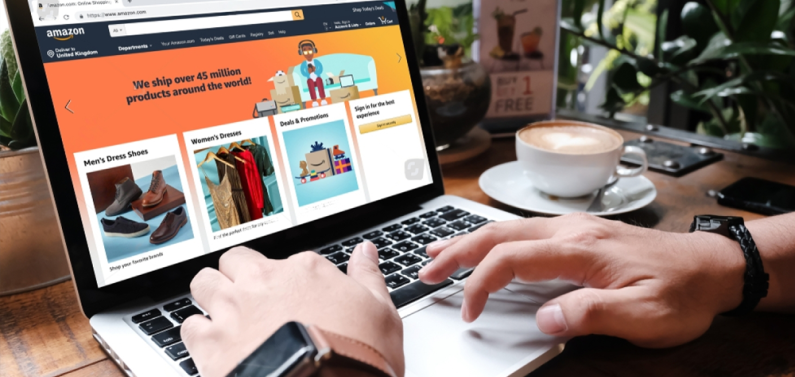What are omnichannel eCommerce and multichannel eCommerce, and what are some strategies?
With multichannel eCommerce, you sell products through independent channels like an online store, a mobile app, or third-party marketplaces.
Omnichannel eCommerce is a more integrated approach. It focuses on creating a smooth and consistent customer experience across all online and offline channels. For example, a customer could begin their shopping journey on a mobile app, switch to a website for more information, and then purchase in a physical store.
Introduction
Relying on a single sales channel is a thing of the past. Literally no eCommerce entrepreneur does that anymore.
The most successful online brands today sell across multiple platforms and channels.
Sure, they have a website.
But they also have stores on eBay and Amazon. They have mobile apps and sell directly on social media. Some of the biggest eCommerce brands also have a big offline presence with brick-and-mortar stores.
Multichannel and omnichannel eCommerce is about having multiple ways for customers to buy stuff.
There are differences between these strategies, but both share a similar goal - to make it as easy as possible for customers to find your products and make a purchase.
And the best part?
By providing convenience and choice, you can keep shoppers coming back for more. Companies with solid omnichannel engagement typically retain 89% of their customers, compared to 33% of businesses with weakened omnichannel customer experience.
In this guide, we’ll explore the differences between multichannel and omnichannel eCommerce. You’ll also learn the strategies you can implement today to help your business thrive.
Let’s get started.
Omnichannel vs. multichannel eCommerce

Omnichannel and multichannel eCommerce have different approaches to selling products.
Multichannel eCommerce is about offering several independent channels for customers to buy products. You might have an online store and a presence on third-party marketplaces.
This can be a super effective way to boost sales. A recent study found that customers that interacted with three or more channels bought 250% more frequently than customers who engaged with only one channel.

Macy’s rocks the multichannel approach. Customers can enjoy the convenience of shopping online, explore the physical store experience, or even use third-party platforms to get Macy’s products.
Multichannel commerce gives customers choices. But the experience may differ across platforms.
Omnichannel eCommerce takes things to the next level. It aims to create a seamless and unified customer experience across all online and offline channels. The different channels are all connected. Customers can effortlessly move between channels and get a consistent brand experience.
Apple has an incredible omnichannel customer experience growth strategy. You can buy Apple products online, reserve them for in-store pickup, get help from their knowledgeable staff, and even have your devices serviced at authorized centers. The experience is consistent and connected across all channels. It’s one of the reasons the brand is so successful - customers feel like they are part of the Apple family.
It’s not just major brands that are leveraging omnichannel. On average, 52% of eCommerce sites have omnichannel capabilities.
You don’t even need to buy any inventory upfront to get started with these strategies. Check out the resources below to learn how to start a dropshipping business and which products to sell:
- How to Start a Dropshipping Business in 7 Easy Steps
- 50 Best Dropshipping Products That Will Make Money in 2023
10 omnichannel & multichannel eCommerce strategies to implement right away
Ready to level up your online business?
We’re about to reveal 10 omnichannel and multichannel strategies you can use to boost sales.
You’ll learn what each growth strategy involves, how to implement it, and what to avoid. We’ll also show a bunch of real-world examples to inspire you.
Let’s dive in.
Omnichannel strategies
1. Unified customer profiles
Imagine having a comprehensive view of each customer’s unique preferences and purchase history. You could even track every customer interaction across all your sales channels.
That’s what unified customer profiles do.
You can consolidate your customer data into a single, holistic view. This lets you personalize the customer experience and deliver super-relevant product recommendations.
How to implement:
Invest in a CRM system
A Customer Relationship Management (CRM) system is the foundation for creating unified customer profiles. It keeps track of all your customer interactions, collecting valuable data and enabling you to deliver personalization at scale.
Collect data across channels
You can capture valuable data from your website, social media, mobile apps, and customer support interactions. This can include demographics, purchase history, preferences, and more.
Personalize the experience
Analyze the data you’ve collected to understand customer preferences and behavior. Use this knowledge to create relevant product recommendations, tailored offers, and targeted marketing campaigns.
Real-world example:

Sephora is an excellent example of how to use data to create a unified customer journey. They collect data on customers’ purchases, product reviews, and preferences.
They use this data to provide personalized recommendations, exclusive offers, and even customized in-store experiences. It allows them to create tailored customer journeys across multiple channels.
2. Seamless mobile experience
Mobile-first strategies can help you connect with your customers wherever they are. Whether browsing your mobile app, visiting your website on a smartphone, or engaging through social media, the experience remains unified and consistent.
How to implement:
Responsive design
Make sure your online store has a responsive design or theme. That means it automatically adjusts the layout to fit different screen sizes so your content looks great and is easily accessible on mobile devices.
If you use Shopify, this should happen automatically. The vast majority of themes are responsive.
Mobile payments
Simplify the checkout process by enabling mobile payment options like digital wallets or one-click checkout. This reduces friction and helps customers complete transactions quickly and securely.
Push notifications
Use mobile push notifications to engage customers. You can send personalized notifications based on user preferences. That could include abandoned cart reminders, exclusive offers, or personalized product recommendations.
There are a bunch of Shopify Apps and WooCommerce plugins you can use to add this functionality to your store.
Real-world example:

The online fashion retailer ASOS nails the mobile experience. It synchronizes user accounts, shopping carts, and preferences across mobile, desktop, and tablet. This lets customers seamlessly switch between devices. ASOS also simplifies the mobile checkout process to reduce friction and cart abandonment.
Discover more ways to boost conversions in our ultimate eCommerce optimization guide.
3. Social media integration
Consumers use social media to connect, share, and even shop. Sales on social media platforms are predicted to be worth $1.298 billion in 2023.
Making social media a key part of your omnichannel marketing growth strategy can help you engage customers and drive traffic to your online store. You can use in-built social media shopping features to create a memorable customer buying experience.
If you need some help keeping on top of all your social profiles, check out our list of the best AI tools for eCommerce. There are some super helpful tools to help you monitor your social presence and engage your followers.
How to implement:
Social commerce features
Make the most of social commerce features offered by platforms like Instagram and Facebook. Tag your products in posts and stories with direct links to the product pages for a smooth shopping experience.
Some platforms allow you to add a “buy now” button that lets customers make purchases without leaving the platform.
User-generated content (UGC)
Encourage customers to share their experiences, reviews, and photos of your products. This type of content acts as powerful social proof. It can build trust and confidence in your product, encouraging others to make a purchase.
Social listening
Keep an ear to the ground! Monitor and respond to customer inquiries and mentions on social media. Provide top-notch customer support and address any customer concerns to show that you care.
Real-world example:

Glossier knows how to win at social media. The beauty brand uses platforms like Instagram, Twitter, and YouTube to engage customers and boost sales.
It often features user-generated content, customer reviews, and impressive before-and-after photos. This promotes Glossier’s products and encourages other customers to join the conversation and share their experiences.
4. Personalized retargeting
Ever felt like a product was following you around online? You look at a product on one site and later see the same product in ads on social media and other websites.
That’s personalized retargeting in action. It’s a powerful growth strategy that lets you reconnect with customers who have shown interest in your products. You can use personalized retargeting campaigns to keep your brand in front of shoppers and capture more sales.
How to implement:
Tracking pixels
Use tracking pixels to track user behavior on your website. This data includes actions like product views, cart abandonment, and specific pages visited. It forms the foundation for your personalized retargeting campaigns.
It’s also simple to do. You can easily install tracking pixels for the two biggest ad platforms - Facebook and Google Ads.
Personalized ads
Use the collected data to create ads tailored to customers’ interests. Show them ads featuring the exact products they viewed or recommend related items based on their browsing history.
Dynamic product remarketing
You can use dynamic product remarketing to ensure your ads are automatically updated based on user interactions. It can be super effective. The average clickthrough rate (CTR) for retargeting ads is 10x higher than regular display ads.
Remarketing is one of the most cost-effective ways to promote your products. You can learn more affordable marketing techniques in our guide on how to grow your business during a recession.
Real-world example:

Amazon is a pro at personalized retargeting. After visiting Amazon, shoppers see ads for the products they viewed on other websites. Amazon uses personalized retargeting to keep its products top of mind and entice customers to return and make a purchase.
5. Loyalty programs
Loyalty programs are an integral part of an omnichannel growth strategy. They help you build and maintain customer relationships across multiple channels and touchpoints.
It’s an effective way to encourage repeat purchases and boost customer engagement. According to a recent study, loyalty program members generate 12-18% more revenue per year on average than non-members.
How to implement:
Design your program
Build a tiered loyalty program to motivate customers to level up and unlock more benefits. This can add a touch of exclusivity and keep customers engaged. You can offer exclusive rewards, discounts, and personalized offers.
Seamless integration
Whether customers shop online, in-store, or via a mobile app, they should be able to earn and redeem rewards. One of the reasons Starbucks and other high-profile loyalty programs succeed is because of the consistency they offer.
Personalized recommendations
Use the data you collect through your loyalty program to provide personalized recommendations. Send targeted promotions and relevant content to keep your customers engaged with your brand.
Real-world example:

Best Buy’s My Best Buy loyalty program has been an enormous success in driving customer loyalty and increasing customer lifetime value. Customers can earn points for purchases, writing reviews, and participating in surveys.
The rewards are super-relevant to the needs of shoppers. Loyalty members can access member-only pricing, exclusive promotions, free shipping, and extended return periods.
Multichannel strategies
6. Sell on third-party platforms
Online marketplaces like Amazon, eBay, and Etsy attract millions of customers daily. You can tap into a vast customer base and benefit from the established brand recognition.
Shoppers are more likely to take a chance on your product if it’s listed on Amazon than if they stumbled across your store through an ad or Google search.
How to implement:
Choose the right marketplaces
Look for marketplaces that align with your target market. You want to ensure the online marketplace attracts people likely to be interested in your products.
If you sell unique products, Etsy is a good option. For more general products, Amazon or eBay could be a better fit.
Optimize your listings
Set up accounts and make your product listings shine. Pay attention to descriptions, images, and keywords to stand out and increase your product visibility.
Marketplaces can be very competitive. You should consider paid ads to help you make the all-important first few sales.
Consider fulfillment options
Keeping on top of inventory management and shipping can be challenging. Consider using fulfillment services to handle these tasks for you.
For example, Amazon FBA is one of the most popular ways to sell online. And your products will be eligible for Amazon Prime - a significant factor in shopper purchasing decisions.
If you’re not sure Amazon FBA is right for you, check out our guide on the best eCommerce business models.
Real-world example:

The athletic apparel brand Under Armour has successfully expanded its reach by selling directly on the Amazon marketplace. While it traditionally focused on wholesalers to sell its products, the brand has made Amazon a key part of its direct-to-consumer (DTC) growth strategy.
Selling directly on Amazon has helped Under Armour expand its DTC sales to over 38% of its total revenue in 2023.
7. Click-to-call and live chat
Click-to-call and live chat features give customers convenient communication options. Shoppers can tap a button on your website to call or chat with a customer support agent. It’s all about being there when customers have questions or need assistance.
How to implement:
Choose a customer support platform
The easiest way to add these features to your store is with customer support software. You can use standalone tools or integrated customer service platforms.
Integration
This typically involves adding code snippets or integrating APIs provided by the platform. Depending on your website and the tool you’ve chosen, you may need assistance from developers.
Design and placement
Make sure the new features match your existing website aesthetics. You should also make the buttons easily accessible. Most eCommerce stores use a floating button or sidebar.
Real-world example:

Zappos is an excellent example of how to implement this omnichannel growth strategy. Customers can easily access the live chat feature and chat with representatives for instant help. They also offer phone, email, and other customer support options.
8. AR and VR experiences
Augmented Reality (AR) and Virtual Reality (VR) can revolutionize the shopping experience. These cutting-edge technologies transform how customers buy products.
You can immerse customers in virtual experiences that engage their senses and help them make informed purchasing decisions. It’s all about creating that “wow” factor.
How to implement:
Define your goals
Determine what you want to achieve with AR or VR. Do you want to boost customer engagement, reduce returns, or provide a unique shopping experience? Define your objectives before you start any project.
Identify suitable products
Choose products that can really benefit from VR or AR. Think of complex or customizable items that customers want to try before buying. Furniture, apparel, cosmetics, and home decor are all great options.
Develop the experience
Team up with developers to create an immersive and user-friendly VR or AR experience. You can integrate the experience into your product pages using APIs, plugins, or embedded 3D models.
Real-world example:

IKEA’s Place app is an excellent example of how to use AR technology to enhance the shopping experience. Customers can use the app to virtually place furniture in their homes and see how it looks before buying. This immersive experience empowers shoppers to make confident decisions. It also has a ‘wow’ factor to help IKEA stand out.
9. Influencer collaborations
Influencer collaboration marketing has been a game-changer for eCommerce brands. Influencers have the ability to authentically connect with their followers. Their endorsement can drive brand awareness and generate interest in your products.
An influencer collaboration is essentially a strategic alliance between a brand or individual and a social media influencer, where the influencer promotes the products, services, or messages of the collaborating entity to their follower base. This partnership is created to leverage the influencer's credibility, authenticity, and reach within a specific niche or industry. The collaboration typically involves the creation of content, such as sponsored posts, reviews, or endorsements, by the influencer that aligns with the brand's objectives. This approach allows brands to tap into the influencer's engaged audience, fostering brand awareness, credibility, and, ultimately, driving consumer action.
How to implement:
Identify relevant influencers
Find influencers with an established audience in your niche. Make sure they align with your brand image and have an authentic following.
Collaborate on content
You can collaborate on sponsored posts, product reviews, or giveaways on social media. Let them showcase your products in a way that resonates with their audience. It can be a great way to generate buzz and boost brand awareness.
Offer exclusive discounts
Give influencers unique discount codes for them to share with their followers. It’s a win-win! Their audience is incentivized to purchase, and you can track the collaboration’s effectiveness. It also provides some extra motivation for the influencer collaboration to promote your products and engage their followers.
Real-world example:

Gymshark frequently collaborates with fitness influencers and athletes to promote their activewear on social media. These influencer collaborations showcase Gymshark products in their workouts, offer honest reviews, and share the products with followers.
This partnership helps Gymshark gain exposure to new customers and enhance brand credibility in the fitness community.
10. Subscription boxes
Subscription boxes are one of the biggest trends in eCommerce. The industry is set to grow at over 65% year-over-year to reach a market size of $904.28 billion by 2026.
You can establish a recurring revenue stream and build long-term customer loyalty by implementing a subscription model.
How to implement:
Identify subscription-worthy products
Choose products that fit a subscription model. Think about items customers frequently purchase or consume as part of a regular routine. Meal kits, beauty products, and pet supplies are good examples.
Create tiered options
Let customers choose a subscription tier that suits their needs. You can offer exclusive products, early access to new releases, or extra perks for higher-tier subscribers. This tiered approach creates exclusivity.
Promote the benefits
Highlight the convenience and cost savings of your subscription boxes. Clearly communicate the value to persuade customers to hit that subscribe button.
Real-world example:

Birchbox is a great example of an eCommerce brand that gets the subscription model right. Every month, subscribers receive a box filled with curated beauty samples and full-sized products. Subscribers can try new products, discover brands, and receive personalized recommendations.
Things to watch out for
You can achieve awesome results with omnichannel and multichannel strategies. But there are also some common issues you should be aware of.
Here are the common problems brands encounter:
1. Data privacy
Make sure you comply with data customer privacy regulations and handle customer data securely. Be transparent about the information you collect and how you use it.
Let customers know the benefits of providing their data. Around 90% of consumers are happy to share their data to receive exclusive discounts on products they’re interested in.
2. Poor mobile experience
Optimize your website to load lightning-fast. Slow loading times lead to user frustration and cart abandonment. Compress images, minify code, and use caching techniques to boost performance.
Test your website on different devices and operating systems to ensure everything works as it should. Regular testing helps you quickly identify and resolve any compatibility issues or glitches.
3. Consistent branding
Maintain a consistent brand image across all platforms. Make sure your brand voice and visual identity align with your overall marketing growth strategy. Be memorable and true to who you are!
4. Ad frequency
Be mindful of how often you show retargeting ads. You don’t want to bombard customers with the same ads over and over again. That can make shoppers less likely to take action. It can even result in users flagging your ad as not relevant, which could increase your advertising costs.
5. Relevant rewards
Make sure the benefits of your loyalty program are relevant to your target audience. Customers need to see the value of participating and earning rewards. If the rewards appear insignificant or unattainable, they won’t actively engage with the program.
6. Marketplace fees
Marketplace fees can nibble away at your profits. You’ll need to account for listing fees, transaction fees, and any commission charges. Crunch the numbers and make sure your pricing growth strategy leaves you with a reasonable profit margin.
7. Optimize response times
Customers expect quick responses in real-time communication channels.
Keep an eye on your social channels and promptly reply to comments and complaints. If you’re actively using social media as a marketing channel, shoppers will expect you to be there for customer support when they reach out on social channels.
AI chatbots can handle initial customer inquiries and route urgent requests to your live customer service team. This can help you deliver timely support.
8. Research influencers before you collaborate
Do your homework!
Look for influencers with engaged followings to ensure their endorsement will resonate with your target audience.
You should also set clear guidelines for influencer collaborations to maintain brand integrity. Communicate your values, messaging, and desired outcomes.
You don’t want to damage your brand by partnering with an influencer that creates inappropriate content.
Live case studies and examples
Time to dive into some real-world success stories.
We’ve got three examples of companies that nailed it with their omnichannel and multichannel eCommerce strategies.
Prepare to be inspired.
Warby Parker

Warby Parker has mastered the art of omnichannel eCommerce by seamlessly integrating online and offline sales channels. The website, mobile app, and physical stores create a seamless shopping experience.
But the real stand out is the “Home Try-On” program.
Customers can pick out frames online, get them shipped for free to try at home, and then head to a store or use the app to make a purchase. Convenience and personalization combined!
The Warby Parker model really clicks with customers. Since its founding in 2010, the eyewear brand has become a billion-dollar company.
Casper

The well-known mattress brand utilizes omnichannel strategies to provide customers with a seamless shopping experience.
Casper has a robust eCommerce store that serves as the central hub for its omnichannel commerce growth strategy.
Even though Casper is known for its online presence, they’ve expanded offline with brick-and-mortar stores called “Casper Sleep Shops.” These stores let customers try out the mattresses in person and get assistance from Casper’s sleep experts.
In-store purchases can also be linked to customer accounts, allowing for post-purchase support and personalized recommendations.
Target

Target allows customers to shop however they want – online, in-store, or a mix of both.
The mobile app allows shoppers to explore products, snag exclusive deals, and make purchases. There’s even a handy BOPIS (Buy Online, Pick Up In Store) service. You can order online and swing by your nearest Target store for a quick pickup.
Target’s strategies put customer satisfaction and convenience first. And it’s paying off big time. While many big box retailers were forced to permanently close some of their stores, Target’s net store count increased by 32 in 2021.
Drive growth with omnichannel and multichannel eCommerce
Omnichannel and multichannel eCommerce strategies are a must-have in today’s digital world.
These strategies expand the number of ways customers can engage with your brand and make purchases. You can reach a wider audience, increase sales, and boost revenue potential.
If you’re on the hunt for reliable suppliers, look no further than the SaleHoo Directory. You’ll find thousands of trusted suppliers offering high-quality products for your business.
And if dropshipping is more your style, check out SaleHoo Dropship. You can access the most lucrative dropshipping products on AliExpress, all handpicked by our eCommerce experts, and add them to your Shopify store in a couple of clicks.
Contact our 24/7 support team if you have any eCommerce-related questions or need help getting started with the strategies we’ve covered in this guide.











